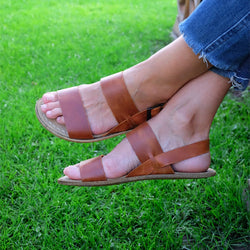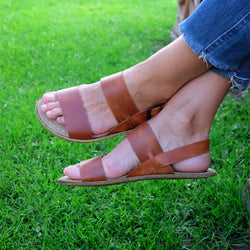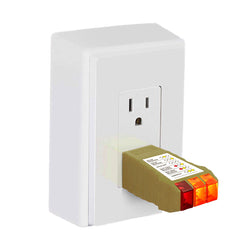In recent years, there has been a growing trend towards reconnecting with the natural world and embracing minimalist lifestyles. From organic food to eco-friendly products, people are striving to live healthier, more authentic lives. One area where this trend is particularly evident is in the world of footwear. As more and more individuals become aware of the potential harms of traditional shoes, they are turning to barefoot shoes that are grounded. These shoes, often made of sustainable materials and designed to mimic the feeling of walking barefoot, offer a range of benefits that go far beyond mere comfort.
Are Modern Shoes Bad For Your Feet? Unveiling the Truth About Shoe-Induced Malformations
For centuries, humans have been wearing shoes to protect their feet. However, in recent decades, the design and construction of shoes have changed dramatically. With the advent of mass production and synthetic materials, modern shoes have taken a stark departure from the natural shape of our feet. They've become rigid contraptions that force our feet into unnatural, contorted positions. The very essence of our footwear has morphed into instruments of constraint and discomfort. We're squeezing our feet into footwear, rather than allowing footwear to embrace and accommodate the unique contours of our feet. This has led to a host of foot problems, including bunions, toenail deformities, hammertoes, and collapsed arches. Let's delve deeper into the issue of bunions. A bunion is a bony bump that forms at the base of the big toe, causing it to deviate from its natural alignment. This deformity is often painful and can make walking or wearing certain shoes extremely uncomfortable. The rise in popularity of fashionable, yet impractical footwear has contributed significantly to the increasing prevalence of bunions.
Let's delve deeper into the issue of bunions. A bunion is a bony bump that forms at the base of the big toe, causing it to deviate from its natural alignment. This deformity is often painful and can make walking or wearing certain shoes extremely uncomfortable. The rise in popularity of fashionable, yet impractical footwear has contributed significantly to the increasing prevalence of bunions. Similarly, hammertoes have become a common foot problem due to the design of modern shoes. A hammertoe is a deformity that causes one or more of the toe joints to bend abnormally, resembling a hammer. This condition can be painful and make it difficult to find shoes that fit properly. The rigid and narrow toe boxes in many modern shoes force the toes into unnatural positions, leading to the development of hammertoes.
Similarly, hammertoes have become a common foot problem due to the design of modern shoes. A hammertoe is a deformity that causes one or more of the toe joints to bend abnormally, resembling a hammer. This condition can be painful and make it difficult to find shoes that fit properly. The rigid and narrow toe boxes in many modern shoes force the toes into unnatural positions, leading to the development of hammertoes.
 Collapsed arches, also known as flat feet, have also become more prevalent. The arches of the feet are designed to provide support and distribute the body's weight evenly. Paradoxically, the use of cushioned soles and arch support in modern shoes has weakened the muscles and tendons in the feet. This weakening can result in the arches collapsing, causing discomfort and affecting the overall stability of the feet.
Collapsed arches, also known as flat feet, have also become more prevalent. The arches of the feet are designed to provide support and distribute the body's weight evenly. Paradoxically, the use of cushioned soles and arch support in modern shoes has weakened the muscles and tendons in the feet. This weakening can result in the arches collapsing, causing discomfort and affecting the overall stability of the feet.
Furthermore, the restrictive nature of modern shoes, with their cushioned soles and arch support, has a detrimental effect on the natural movement and articulation of the foot. The foot is a complex structure with numerous bones, joints, muscles, and tendons that work together to provide stability and mobility. When these natural movements are restricted by the design of shoes, the muscles and tendons in the feet become weak and unable to support the body's weight effectively.

It is important to note that while modern impractical shoes are contributing to vast array of foot problems, they are not the sole cause. Other factors such as genetics, foot shape, and lifestyle choices also play a role in the development of feet malformations. However, it is clear that the design and construction of shoes have a significant impact on our foot health.
In conclusion, the rise in popularity of fashionable yet impractical footwear has led to an increase in foot problems such as bunions, hammertoes, and collapsed arches. The rigid and restrictive nature of modern shoes can squeeze the feet into unnatural positions, extra cushioning can weaken the muscles and tendons and preventing the natural movement of all the little muscles in the foot. While shoes are essential for protecting our feet, it is crucial to choose footwear that prioritizes foot health that leads to more comfort.
What Are Barefoot Shoes? Benefits and Science Behind Natural Walking
So, what exactly are barefoot shoes? Unlike traditional shoes, barefoot shoes are designed to allow your feet to move as naturally as possible. They typically have thin, flexible soles that provide minimal interference with the natural mechanics of walking. The idea behind barefoot shoes is to create an experience similar to walking barefoot on natural surfaces, such as grass or sand.
When we walk barefoot, our feet are constantly adapting to the terrain beneath us. This stimulates the muscles, tendons, and ligaments in our feet and lower legs, promoting strength and flexibility. Barefoot shoes aim to replicate this sensation, giving wearers the benefits of walking barefoot while still protecting their feet from sharp objects and extreme temperatures.
Scientific studies have shown that walking in barefoot shoes can lead to improved balance, increased ankle stability, and enhanced proprioception - the body's ability to sense its position in space. Additionally, barefoot walking has been found to reduce impact forces on the joints, potentially reducing the risk of injury and pain.
What is Grounding? Discovering its Origins and Relevance Today
Grounding, also known as Earthing, refers to the practice of connecting our bodies to the Earth's vast supply of electrons. It is believed that this connection can have a profound impact on our overall well-being. When we walk barefoot, our feet make direct contact with the Earth, allowing us to absorb its electrons, which are thought to have antioxidant effects on the body. This can help reduce inflammation, improve sleep quality, and enhance overall vitality.
Barefoot shoes that are grounded take this concept a step further. They feature special conductive materials in the soles that allow for a direct connection to the Earth, even when wearing shoes. This technology ensures that wearers enjoy the benefits of grounding, regardless of terrain or weather conditions. By incorporating grounding into everyday footwear, these shoes offer a new pathway to wellness.
The concept of grounding is not new. In fact, it has its roots in ancient practices and wisdom. Indigenous cultures have long recognized the healing power of the Earth and have incorporated grounding practices into their daily lives. Whether it's walking barefoot, sitting on the ground, or simply connecting with nature, these cultures have understood the importance of staying connected to the Earth's energy.
Today, as we spend more time indoors and surrounded by technology, we have become increasingly disconnected from the Earth's energy. This disconnection has been linked to a range of health problems, including chronic inflammation, sleep disorders, and reduced immune function. By reintroducing grounding into our lives through barefoot shoes that are grounded, we can tap into the Earth's healing energy and promote overall wellness.
Are Rubber Soles Bad? Health Concerns with Non-Grounded Footwear
One of the main concerns with non-grounded footwear, particularly those with rubber soles, is their insulating properties. Rubber is a natural insulator, meaning it inhibits the flow of electrons between our feet and the Earth. When we wear shoes with rubber soles, we effectively cut off our connection to the Earth's electrical charge. This lack of grounding can have negative consequences for our health. As mentioned earlier, grounding has been linked to reduced inflammation and pain. Without this connection, our bodies may become more susceptible to chronic inflammation, which is a common underlying factor in many diseases, including cardiovascular disease, arthritis, and even cancer.
This lack of grounding can have negative consequences for our health. As mentioned earlier, grounding has been linked to reduced inflammation and pain. Without this connection, our bodies may become more susceptible to chronic inflammation, which is a common underlying factor in many diseases, including cardiovascular disease, arthritis, and even cancer.
Furthermore, non-grounded footwear can contribute to the buildup of static electricity in the body. This can lead to discomfort, fatigue, and even disrupted sleep. By choosing barefoot shoes that are grounded, we can avoid these potential health risks and reap the benefits of staying connected to the Earth.
Barefoot Shoes That Are Grounded: Reintroducing Traditional Techniques in Today's Footwear
Fortunately, there are brands and designers who recognize the importance of both barefoot walking and grounding. For example, we have created barefoot shoes that are grounded, taking inspiration from traditional techniques and integrating modern technology. Our shoes are made from sustainable, locally sourced materials and are designed to provide the natural, unrestricted movement that our feet need.
Our Earthing Harmony shoes embody the essence of barefoot walking, featuring naturally shaped wide-toe box for free movement, no toe spring and no arch support — for ultimate barefoot walking stimulation and health benefits. Every shoe comes with a 100% copper rivet which acts as a main conductor.
By incorporating conductive materials into the soles, these shoes ensure that wearers can enjoy the benefits of grounding, even in urban environments. Our shoes offer a bridge between the modern world and our primal roots, allowing us to step into wellness while treading lightly on the Earth.
The Surprising Benefits of Being Grounded
Aside from all the potential health benefits, being grounded can have a profound impact on our overall well-being. Many people report feeling more centered, calm, and connected when they spend time in direct contact with the Earth. This connection can help reduce stress, improve mood, and enhance mental clarity.
Additionally, grounding has been found to improve sleep quality. By restoring our natural circadian rhythms and reducing the effects of electromagnetic radiation, grounding can promote deeper, more restful sleep. This, in turn, can have a positive impact on our energy levels, cognitive function, and overall vitality.
Environmental Impact: Comparing Rubber Shoes to Sustainable, Locally Sourced Leather Shoes
While the health benefits of barefoot shoes that are grounded are apparent, it is also essential to consider their environmental impact. The production of conventional shoes, especially those with rubber soles, can have significant environmental consequences.
Rubber production often involves deforestation, habitat destruction, and the use of toxic chemicals. Additionally, the transportation of rubber and other synthetic materials contributes to greenhouse gas emissions and pollution. These factors make traditional shoes a less sustainable choice.
On the other hand, our barefoot shoes that are grounded prioritize sustainability and ethical production practices. We use locally sourced leather, which reduces the carbon footprint associated with transportation. Additionally, by choosing natural, sustainable materials and adopting circular design principles, these handcrafted shoes minimize waste and prevent further harm to the environment.
How to Transition to Grounded Barefoot Shoes: Tips and Benefits for First-Time Users
If you are considering transitioning to barefoot shoes that are grounded, there are a few tips to keep in mind. First and foremost, take it slow. Your feet may need time to adjust to the new sensation of walking in minimalist shoes.
Start by wearing your barefoot shoes for short periods each day, gradually increasing the duration as your feet become stronger and more accustomed to the new movement patterns. It is also essential to listen to your body and pay attention to any discomfort or pain. If you experience any issues, consult with a podiatrist or other healthcare professional.
As you make the transition, you may notice several benefits. These may include improved posture, increased muscle tone in your feet and legs, enhanced balance, and reduced foot, ankle, and knee pain. Embracing grounded barefoot shoes can be a transformative journey towards better overall wellness.
In conclusion, the benefits of barefoot shoes that are grounded extend far beyond mere comfort. By embracing these shoes, we reconnect with the Earth, tap into its healing energy, and promote our overall well-being. Being handcrafted with sustainable materials and minimalist design, our shoes offer a greener, healthier alternative to traditional footwear. So, step into wellness and let your feet explore the world in barefoot shoes that are grounded.







 Shoes
Shoes
 Boots
Boots
 Sandals
Sandals

 Shoes
Shoes
 Boots
Boots
 Sandals
Sandals






















